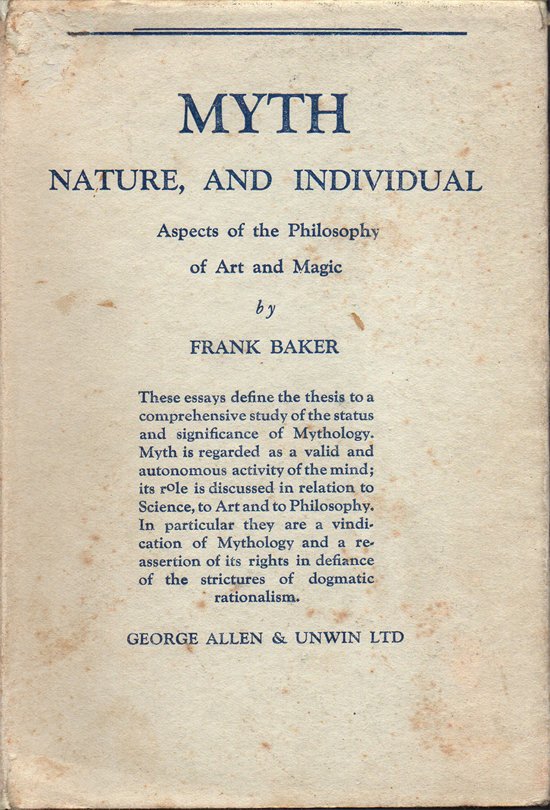Détails
Éditeurs
George Allen & Unwin Ltd, Museum Street
Thème
(Filosofia - Mitologia - Arte)
Description
In-16° (18,2 x 12,2 cm), pp. 135, (1), legatura editoriale in tela con sovraccoperta. Tracce d'uso e del tempo alla sovraccoperta, in particolare: piccoli segni d'umido; qualche menda e alcuni strappetti ai margini, questi ultimi ben rimarginati con carta giapponese applicata nella parte interna; lieve brunitura alla parte che copre il dorso del volume. Pochi, leggeri segni d'umido anche alla legatura, al taglio davanti, alle prime pagine e all'ultima. Al recto della carta di guardia anteriore e al verso di quella posteriore, nella parte interna non a contatto con le alette della sovraccoperta, leggerissimo alone color beige, di perfetta forma rettangolare, che si sviluppa in senso verticale rispetto alla pagina, della larghezza di 3,9 cm per 18,2 cm di altezza, probabilmente determinato, nel tempo, dalla reazione al contatto con le controguardie, fissate, in sede editoriale, con materiale adesivo ai contropiatti. Normale patina del tempo alle pagine, per il resto, ben conservato. Dalla sovraccoperta: «These essays define the thesis to a comprehensive study of the status and significance of Mythology. Myth is regarded as a valid and autonomous activity of the mind; its role is discussed in relation to Science, to Art and to Philosophy. In particular they are a vindication of Mythology and a reassertion of its rights in defiance of the strictures of dogmatic rationalism». Part I. Analysis of Contents I. Introduction. Life and Purpose (The Status of Teleology.) Teleology as makeshift or bastard category. The inadequacy of Teleology to the problems of Eternity. Teleology in Platonic thought. Teleology in Iconoclastic Monotheism (Spinoza), Nietzsche and Teleology. Teleology and society. Teleology in the Philosophy of Schopenhauer. II. The Eternal and the Purposive aspects of Art. Prometheus as Eternal Artist. The Promethean aspect of Art as mirrored in the Heroic Myths. III. The Purposive aspects of Art (continued). Art in the service of Life. Teleological basis of primitive rites. IV. Myth, Religion, and the Origin of the Drama. Interrelations of the Purposive and the Eternal aspects of Art. Contingency of the category of Purpose as applied to Life and Art. V. Magic as the Teleology of Myth. Myth in the service of life. The Relativity of all Formulations. The Pragmatic sanction for Magic. VI. The Teleology of Cannibalism and the relation therein of Myth to Magic. Cannibalism and the Solar and Manistic Cults. VII. Teleology of Cannibalism (continued). The Significance of Pain in relation to the Origin of the Beautiful. Art as a "Marriage of Heaven and Hell". Dionysian and Apollinian States. Pain integral to Life. VIII. Reinterpretation of the significance of the Eternal and the Purposive aspects of Art, as the relation of Myth to Organism. Relation of the Artist to Nature. The meaning of Movement as bond between Artist and Nature. Characteristics of Organism elucidated. Rejuvenescence, Symbiosis, Polarity. IX. Final interpretation of the significance and Teleology of Cannibalism. The Common basis of Cannibal and Phallic rites. The transvaluation of values and the metamorphosis of Symbols. Sublimation and the trasformation of vital emphasis. X. Conclusion. Consciousness and Tragedy correlative terms. Intellectual Harmony and Vital Harmony. The Eternal and the Purposive aspects of Reality. The Irreducible antitheses. The Significance of the transition from the Animistic to the Manistic state. Tragic Myth as the epitome of Conscious Life. Part II. Analysis of Contents The Myth of Reality and the Reality of Myth: the Status and Significance of Mythology. Section I. Myth, Science and Consciousness. A. Fact and Phantasy. B. Dream Life and Waking Life. C. Space, Time, and Reality. Section II. Æsthetics, Mythology and Metaphysics. A. TheÆsthetics of Creation. B. Music and Image (i). Music and Image (ii). C. The Antinomy of the Real.

Découvrez comment utiliser
Découvrez comment utiliser

